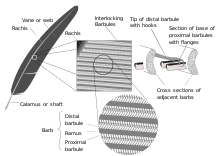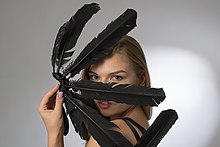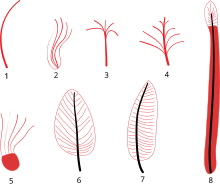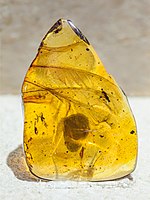Feather

Feathers are
Although feathers cover most of the bird's body, they arise only from certain well-defined tracts on the skin. They aid in flight, thermal insulation, and waterproofing. In addition, coloration helps in communication and protection.[5] The study of feathers is called plumology (or plumage science).[6][7]
People use feathers in many ways that are practical, cultural, and religious. Feathers are both soft and excellent at trapping
Etymology
Feather derives from the Old English "feþer", which is of Germanic origin; related to Dutch "veer" and German "Feder", from an Indo-European root shared by Sanskrit's "patra" meaning 'wing', Latin's "penna" meaning 'feather', and Greek's "pteron", "pterux" meaning 'wing'.
Because of feathers being an integral part of quills, which were early pens used for writing, the word pen itself is derived from the Latin penna, meaning feather.[10] The French word plume can mean feather, quill, or pen.
Structures and characteristics

- Vane
- Shaft, rachis
- Barb
- Aftershaft, afterfeather
- Quill, calamus
Feathers are among the most complex

Classification
There are two basic types of feather: vaned feathers which cover the exterior of the body, and down feathers which are underneath the vaned feathers. The pennaceous feathers are vaned feathers. Also called contour feathers, pennaceous feathers arise from tracts and cover the entire body. A third rarer type of feather, the filoplume, is hairlike and are closely associated with pennaceous feathers and are often entirely hidden by them, with one or two filoplumes attached and sprouting from near the same point of the skin as each pennaceous feather, at least on a bird's head, neck and trunk.[14][15] Filoplumes are entirely absent in ratites.[16] In some passerines, filoplumes arise exposed beyond the pennaceous feathers on the neck.[1] The remiges, or flight feathers of the wing, and rectrices, or flight feathers of the tail, are the most important feathers for flight. A typical vaned feather features a main shaft, called the rachis. Fused to the rachis are a series of branches, or barbs; the barbs themselves are also branched and form the barbules. These barbules have minute hooks called barbicels for cross-attachment. Down feathers are fluffy because they lack barbicels, so the barbules float free of each other, allowing the down to trap air and provide excellent thermal insulation. At the base of the feather, the rachis expands to form the hollow tubular calamus (or quill) which inserts into a follicle in the skin. The basal part of the calamus is without vanes. This part is embedded within the skin follicle and has an opening at the base (proximal umbilicus) and a small opening on the side (distal umbilicus).[17]
Hatchling birds of some species have a special kind of natal down feathers (neossoptiles) which are pushed out when the normal feathers (teleoptiles) emerge.[1]
Flight feathers are stiffened so as to work against the air in the downstroke but yield in other directions. It has been observed that the orientation pattern of β-keratin fibers in the feathers of flying birds differs from that in flightless birds: the fibers are better aligned along the shaft axis direction towards the tip,[18][19] and the lateral walls of rachis region show structure of crossed fibers.[20][21]
Functions
Feathers insulate birds from water and cold temperatures. They may also be plucked to line the nest and provide insulation to the eggs and young. The individual feathers in the wings and tail play important roles in controlling flight.
Some birds have a supply of

Grebes are peculiar in their habit of ingesting their own feathers and feeding them to their young. Observations on their diet of fish and the frequency of feather eating suggest that ingesting feathers, particularly down from their flanks, aids in forming easily ejectable pellets.[28]
Distribution

Contour feathers are not uniformly distributed on the skin of the bird except in some groups such as the
Coloration
The colors of feathers are produced by pigments, by microscopic structures that can refract, reflect, or scatter selected wavelengths of light, or by a combination of both.
Most feather pigments are

The blues and bright greens of many parrots are produced by constructive interference of light reflecting from different layers of structures in feathers. In the case of green plumage, in addition to yellow, the specific feather structure involved is called by some the Dyck texture.[37][38] Melanin is often involved in the absorption of light; in combination with a yellow pigment, it produces a dull olive-green.

In some birds, feather colors may be created, or altered, by secretions from the uropygial gland, also called the preen gland. The yellow bill colors of many hornbills are produced by such secretions. It has been suggested that there are other color differences that may be visible only in the ultraviolet region,[24] but studies have failed to find evidence.[39] The oil secretion from the uropygial gland may also have an inhibitory effect on feather bacteria.[40]
The reds, orange and yellow colors of many feathers are caused by various carotenoids. Carotenoid-based pigments might be honest signals of fitness because they are derived from special diets and hence might be difficult to obtain,[41][42] and/or because carotenoids are required for immune function and hence sexual displays come at the expense of health.[43]
A bird's feathers undergo wear and tear and are replaced periodically during the bird's life through
Although sexual selection plays a major role in the development of feathers, in particular, the color of the feathers it is not the only conclusion available. New studies are suggesting that the unique feathers of birds are also a large influence on many important aspects of avian behavior, such as the height at which different species build their nests. Since females are the prime caregivers, evolution has helped select females to display duller colors down so that they may blend into the nesting environment. The position of the nest and whether it has a greater chance of being under predation has exerted constraints on female birds' plumage.[47] A species of bird that nests on the ground, rather than the canopy of the trees, will need to have much duller colors in order not to attract attention to the nest. The height study found that birds that nest in the canopies of trees often have many more predator attacks due to the brighter color of feathers that the female displays.[47] Another influence of evolution that could play a part in why feathers of birds are so colorful and display so many patterns could be due to that birds developed their bright colors from the vegetation and flowers that thrive around them. Birds develop their bright colors from living around certain colors. Most bird species often blend into their environment, due to some degree of camouflage, so if the species habitat is full of colors and patterns, the species would eventually evolve to blend in to avoid being eaten. Birds' feathers show a large range of colors, even exceeding the variety of many plants, leaf, and flower colors.[48]
Parasites
The feather surface is the home for some ectoparasites, notably feather lice (
Parasitic cuckoos which grow up in the nests of other species also have host-specific feather lice and these seem to be transmitted only after the young cuckoos leave the host nest.[50]
Birds maintain their feather condition by
Human usage
Utilitarian


Bird feathers have long been used for
Feathers are also valuable in aiding the identification of species in forensic studies, particularly in bird strikes to aircraft. The ratios of hydrogen isotopes in feathers help in determining the geographic origins of birds.[52] Feathers may also be useful in the non-destructive sampling of pollutants.[53]
The poultry industry produces a large amount of feathers as waste, which, like other forms of keratin, are slow to decompose. Feather waste has been used in a number of industrial applications as a medium for culturing microbes,[54] biodegradable polymers,[55] and production of enzymes.[56] Feather proteins have been tried as an adhesive for wood board.[57]
Some groups of Native people in Alaska have used ptarmigan feathers as temper (non-plastic additives) in pottery manufacture since the first millennium BC in order to promote thermal shock resistance and strength.[58]
In religion and culture

Eagle feathers have great cultural and spiritual value to Native Americans in the United States and First Nations peoples in Canada as religious objects. In the United States, the religious use of eagle and hawk feathers is governed by the eagle feather law, a federal law limiting the possession of eagle feathers to certified and enrolled members of federally recognized Native American tribes.
In South America, brews made from the feathers of
Members of Scotland's Clan Campbell are known to wear feathers on their bonnets to signify authority within the clan. Clan chiefs wear three, chieftains wear two and an armiger wears one. Any member of the clan who does not meet the criteria is not authorized to wear feathers as part of traditional garb and doing so is considered presumptuous.[62]
During the 18th, 19th, and early 20th centuries, there was a booming international trade in plumes for extravagant women's hats and other headgear (including in
More recently, rooster plumage has become a popular trend as a hairstyle accessory, with feathers formerly used as fishing lures now being used to provide color and style to hair.[66]
Feather products manufacturing in Europe has declined in the last 60 years, mainly due to competition from Asia. Feathers have adorned hats at many prestigious events such as weddings and Ladies Day at racecourses (Royal Ascot).
Evolution
Functional considerations
The functional view on the evolution of feathers has traditionally focused on insulation, flight and display. Discoveries of non-flying Late Cretaceous feathered dinosaurs in China,
Molecular evolution
Several genes have been found to determine feather development. They will be key to understand the evolution of feathers. For instance, some genes convert scales into feathers or feather-like structures when expressed or induced in bird feet, such as the scale-feather converters Sox2, Zic1, Grem1, Spry2, and Sox18.[80]
Feathers and scales are made up of two distinct forms of
This may suggest that crocodilian scales, bird and dinosaur feathers, and pterosaur
Feathered dinosaurs
Several non-avian
The majority of dinosaurs known to have had feathers or protofeathers are
In 2010, a carcharodontosaurid named Concavenator corcovatus was found to have remiges on the ulna suggesting it might have had quill-like structures on the ams.[96] However, Foth et al. 2014 disagress with the publication where they point out that the bumps on the ulna of Concavenator are on the anterolateral which is unlike remiges which are in a posterolateral on the ulna of some birds, they consider it more likely that these are attachments for interosseous ligaments.[97] This was refuted by Cuesta Fidalgo and her colleagues, they pointed out that these bumps on the ulna are posterolateral which is unlike that of interosseous ligaments.[98]
Since the 1990s, dozens of feathered dinosaurs have been discovered in the clade Maniraptora, which includes the clade Avialae and the recent common ancestors of birds, Oviraptorosauria and Deinonychosauria. In 1998, the discovery of a feathered oviraptorosaurian, Caudipteryx zoui, challenged the notion of feathers as a structure exclusive to Avialae.[99] Buried in the Yixian Formation in Liaoning, China, C. zoui lived during the Early Cretaceous Period. Present on the forelimbs and tails, their integumentary structure has been accepted[by whom?] as pennaceous vaned feathers based on the rachis and herringbone pattern of the barbs. In the clade Deinonychosauria, the continued divergence of feathers is also apparent in the families Troodontidae and Dromaeosauridae. Branched feathers with rachis, barbs, and barbules were discovered in many members including Sinornithosaurus millenii, a dromaeosaurid found in the Yixian formation (124.6 MYA).[100]
Previously, a temporal paradox existed in the evolution of feathers—theropods with highly derived bird-like characteristics occurred at a later time than Archaeopteryx—suggesting that the descendants of birds arose before the ancestor. However, the discovery of Anchiornis huxleyi in the Late Jurassic Tiaojishan Formation (160 MYA) in western Liaoning in 2009[101][102] resolved this paradox. By predating Archaeopteryx, Anchiornis proves the existence of a modernly feathered theropod ancestor, providing insight into the dinosaur-bird transition. The specimen shows distribution of large pennaceous feathers on the forelimbs and tail, implying that pennaceous feathers spread to the rest of the body at an earlier stage in theropod evolution.[103] The development of pennaceous feathers did not replace earlier filamentous feathers. Filamentous feathers are preserved alongside modern-looking flight feathers – including some with modifications found in the feathers of extant diving birds – in 80 million year old amber from Alberta.[104]
Two small wings trapped in amber dating to 100 mya show plumage existed in some bird predecessors. The wings most probably belonged to enantiornithes, a diverse group of avian dinosaurs.[105][106]
A large phylogenetic analysis of early dinosaurs by Matthew Baron, David B. Norman and Paul Barrett (2017) found that Theropoda is actually more closely related to Ornithischia, to which it formed the sister group within the clade Ornithoscelida. The study also suggested that if the feather-like structures of theropods and ornithischians are of common evolutionary origin then it would be possible that feathers were restricted to Ornithoscelida. If so, then the origin of feathers would have likely occurred as early as the Middle Triassic,[107] though this has been disagreed upon.[108][109] The lack of feathers present in large sauropods and ankylosaurs could be that feathers were suppressed by genomic regulators.[110]
Evolutionary stages

Several studies of feather development in the embryos of modern birds, coupled with the distribution of feather types among various prehistoric bird precursors, have allowed scientists to attempt a reconstruction of the sequence in which feathers first evolved and developed into the types found on modern birds.
Feather evolution was broken down into the following stages by Xu and Guo in 2009:[90]
- Single filament
- Multiple filaments joined at their base
- Multiple filaments joined at their base to a central filament
- Multiple filaments along the length of a central filament
- Multiple filaments arising from the edge of a membranous structure
- Pennaceous feather with vane of barbs and barbules and central rachis
- Pennaceous feather with an asymmetrical rachis
- Undifferentiated vane with central rachis
However, Foth (2011) showed that some of these purported stages (stages 2 and 5 in particular) are likely simply artifacts of preservation caused by the way fossil feathers are crushed and the feather remains or imprints are preserved. Foth re-interpreted stage 2 feathers as crushed or misidentified feathers of at least stage 3, and stage 5 feathers as crushed stage 6 feathers.[111]
The following simplified diagram of dinosaur relationships follows these results, and shows the likely distribution of plumaceous (downy) and pennaceous (vaned) feathers among dinosaurs and prehistoric birds. The diagram follows one presented by Xu and Guo (2009)[90] modified with the findings of Foth (2011)[111] The numbers accompanying each name refer to the presence of specific feather stages. Note that 's' indicates the known presence of scales on the body.
In pterosaurs
Cascocauda was almost entirely covered in an extensive coat of pycnofibres, which appear to have come in two types. The first are simple, curved filaments that range in length from 3.5–12.8 mm long. These filaments cover most of the animal, including the head, neck, body, limbs and tail. The second type consists of tufts of filaments joined near the base, similar to the branching
See also
- Feather development
- Delayed feathering in chickens
- Hen feathering in cocks
- Imping
- List of poultry feathers
- Pinioning
- Plumage
- White feather
References
- ^ (PDF) from the original on 29 June 2011. Retrieved 7 July 2010.
- ^ (PDF) from the original on 29 June 2011. Retrieved 7 July 2010.
- PMID 10578107. Archived from the original(PDF) on 9 April 2011. Retrieved 7 July 2010.
- S2CID 206537426.
- ^ ISBN 0-8087-1609-3.
- ^ "Galapagos plumology" (PDF). darwinfoundation.org. Charles Darwin Collections Database by the Charles Darwin Foundation. Archived from the original on 17 March 2016. Retrieved 24 April 2015.
- ISBN 3-86117-228-3. Archivedfrom the original on 17 December 2017. Retrieved 24 April 2015.
- S2CID 135061282.
- ^ Johnston, Nicole & Parsons, Jean (20 September 2018). "Feathers: Endangered – Fauna and Fashion". University of Missouri's Historic Costume and Textiles Collection.
- ^ "pen(3)". The Merriam-Webster Online Dictionary. Merriam-Webster, Inc. Archived from the original on 19 September 2011. Retrieved 16 October 2010.
- PMID 19431311.
- PMID 14834148.
- PMID 15572138.
- ^ Nitzsch, Christian Ludwig (1867). Nitzsch's Pterylography. Ray Society. p. 14.
- ^ Chandler 1916, p. 261
- ^ Chandler, Asa C. (1916). "A study of the structure of feathers, with reference to their taxonomic significance". University of California Publications in Zoology. 13 (11): 243–446 [284].
- ISBN 0-7216-3536-9.
- PMID 12972348.
- S2CID 135873731.
- ^ PMID 28331789.
- PMID 23762440.
- PMID 12965000.
- (PDF) from the original on 7 July 2010. Retrieved 19 July 2010.
- ^ S2CID 29592388. Archived from the original(PDF) on 3 December 2007.
- .
- The Wilson Bulletin. 84: 193–97. Archived(PDF) from the original on 4 February 2014.
- from the original on 22 February 2014.
- .
- from the original on 21 February 2014.
- S2CID 36055848.
- .
- S2CID 26584982. Archived from the original(PDF) on 20 October 2022. Retrieved 29 July 2020 – via EBSCO.
- PMID 17148123.
- PMID 12590772.
- PMID 17148144. Archived from the original(PDF) on 26 March 2009.
- PMID 19710052. Archived from the original(PDF) on 21 June 2010. Retrieved 19 July 2010.
- ^ Dyck, J. (1971). "Structure and spectral reflectance of green and blue feathers of the Lovebird (Agapornis roseicollis)". Biol. SKR. 18: 1–67.
- .
- PMID 18560743.
- doi:10.1111/j.0908-8857.2003.03193.x. Archived from the original(PDF) on 10 September 2008.
- PMID 28563214.
- S2CID 201965078.
- S2CID 86971117.
- from the original on 23 February 2014.
- ^ Grande, J. M.; Negro, J. J.; Torres, M. J. (2004). "The evolution of bird plumage colouration: A role for feather-degrading bacteria?" (PDF). Ardeola. 51 (2): 375–383. Archived (PDF) from the original on 10 September 2008.
- (PDF) from the original on 20 November 2012.
- ^ PMID 28565684.
- .
- PMID 18461081.
- .
- S2CID 85677766.
- S2CID 1762342.
- PMID 17198730.
- .
- ^ Schmidt, W.F.; Barone, J.R. (2004). "New uses for chicken feathers keratin fiber". Poultry Waste Management Symposium Proceedings. pp. 99–101.
- S2CID 96154497.
- from the original on 19 February 2014.
- ^ Neusius, Sarah W. and G. Timothy Gross 2007 Seeking Our Past: An Introduction to North American Archaeology. Oxford University Press, NY.
- PMID 16677398.
- PMID 15894132.
- PMID 17547781.
- ^ "Scottish Highland Dress: Clan Campbell". Clan Campbell Society. Retrieved 10 November 2020.
- ^ Doughty, Robin W. Feather Fashions and Bird Preservation, A Study in Nature Protection. University of California Press. Page 197.
- ^ Ehrlich, Paul R.; Dobkin, David S.; Wheye, Darryl (1988). "Plume Trade". Stanford University. Archived from the original on 30 September 2008.
- ^ Feather trade Archived 23 June 2008 at the Wayback Machine, Smithsonian Institution
- ^ Bonner, Jessie L. (6 June 2011). "High fashion or bait? Fly ties now hair extensions". The Seattle Times. Archived from the original on 10 June 2011.
- ^ a b St. Fleur, Nicholas (8 December 2016). "That Thing With Feathers Trapped in Amber? It Was a Dinosaur Tail". The New York Times. Archived from the original on 8 December 2016. Retrieved 8 December 2016.
- .
- S2CID 98221211.
- .
- ^ Whitfield, John (4 April 2012). "Largest feathered dinosaur yet discovered in China". Nature News Blog. Archived from the original on 6 April 2012. Retrieved 4 April 2012.
- S2CID 29689629. Archived from the original(PDF) on 17 April 2012.
- S2CID 24319963.
- S2CID 84936431.
- S2CID 206525132.
- ^ Cincotta, A., Nicolaï, M., Campos, H.B.N. et al. Pterosaur melanosomes support signalling functions for early feathers. Nature 604, 684–688 (2022). https://doi.org/10.1038/s41586-022-04622-3
- S2CID 4400888.
- S2CID 25683790.
- S2CID 2057698.
- PMID 29177513.
- PMID 17784647.
- PMID 17784647.
- PMID 21898788.
- S2CID 262125827.
- ^ S2CID 174811556.
- ^
Dimond, C. C.; R. J. Cabin; J. S. Brooks (2011). "Feathers, Dinosaurs, and Behavioral Cues: Defining the Visual Display Hypothesis for the Adaptive Function of Feathers in Non-Avian Theropods". BIOS. 82 (3): 58–63. S2CID 98221211.
- ^
Xu, Xing; Fucheng Zhang (2005). "A new maniraptoran dinosaur from China with long feathers on the metatarsus". Naturwissenschaften. 92 (4): 173–177. S2CID 789908.
- ^
Xu, Xing (2006). "Feathered dinosaurs from China and the evolution of major avian characters". Integrative Zoology. 1 (1): 4–11. S2CID 1516713.
- S2CID 4423110.
- ^ a b c Xu, X.; Guo, Y. (2009). "The origin and early evolution of feathers: insights from recent paleontological and neontological data". Vertebrata PalAsiatica. 47 (4): 311–329.
- S2CID 206556907.
- PMID 26041865.
- ^ a b Those feathers won't stick: maximum likelihood modelling supports scales as primitive for Dinosauria (The 66th Symposium on Vertebrate Palaeontology and Comparative Anatomy), 9 November 2018, archived from the original on 11 December 2021, retrieved 3 October 2021
- S2CID 89156313.
- ^ Holtz, Thomas (19 October 2018). ""Integumentary Status: It's Complicated': Phylogenetic, Sedimentary, and Biological Impediments to Resolving the Ancestral Integument of Mesozoic Dinosauria" (PDF). Society of Vertebrate Paleontology. Retrieved 16 July 2022.
- S2CID 4395795.
- S2CID 4464659.
- S2CID 91976402.
- S2CID 205001388.
- ^
Xu, X.; H. H. Zhou & R. O. Prum (2001). "Branched integumental structures in Sinornithosaurus and the origin of feathers". Nature. 410 (6825): 200–204. S2CID 4426803.
- ^
Hu, D. Y.; L. H. Hou; L. J. Zhang; X. Xu (2009). "A pre-Archaeopteryx troodontid theropod from China with long feathers on the metatarsus". Nature. 461 (7264): 640–643. S2CID 205218015.
- ^ Xu, X.; Q. Zhao; M. Norell; C. Sullivan; D. Hone; G. Erickson; X. L. Wang; et al. (2009). "A new feathered maniraptoran dinosaur fossil that fills a morphological gap in avian origin". Chinese Science Bulletin. 54 (3): 430–435. .
- ^
Witmer, L. M. (2009). "Feathered dinosaurs in a tangle". Nature. 461 (7264): 601–602. S2CID 205049989.
- ^ "Dinosaur feathers found in Alberta amber". CBC News. 15 September 2011. Archived from the original on 15 September 2011.
- ^ "Rare Dinosaur-Era Bird Wings Found Trapped in Amber". 28 June 2016. Archived from the original on 28 June 2016. Retrieved 28 June 2016.
- PMID 27352215.
- S2CID 205254710.
- S2CID 56480710.
- S2CID 205260354.
- S2CID 174811556.
- ^ S2CID 86362907.
- S2CID 222168569.
- S2CID 56480710.
- ^ "Pterosaurs Had Four Types of Feathers, New Study Shows | Paleontology | Sci-News.com". Breaking Science News | Sci-News.com. 18 December 2018. Retrieved 19 December 2018.
- ^ St. Fleur, Nicholas (17 December 2018). "Feathers and Fur Fly Over Pterosaur Fossil Finding – An analysis of two fossils would push back the origins of feathers by about 70 million years, but more specimens may be needed for confirmation". The New York Times. Retrieved 19 December 2018.
- ^ Briggs, Helen (17 December 2018). "Fur flies over new pterosaur fossils". BBC News. Retrieved 19 December 2018.
- S2CID 56480834.
- S2CID 56480710.
- S2CID 222168569.
- S2CID 222163211.
Further reading
- Hanson, Thor (2011). ISBN 978-0-465-02013-3.
- Lucas, Alfred M.; Stettenheim, Peter R. (1972). "Structure of feathers". Avian Anatomy Integument. Vol. Part 1. Washington D.C.: US Department of Agriculture. pp. 235–276.
External links
- McGraw, K. J. 2005. Polly want a pigment? Cracking the chemical code to red coloration in parrots. Australian Birdkeeper Magazine 18:608–611.
- DeMeo, Antonia M. Access to Eagles and Eagle Parts: Environmental Protection v. Native American Free Exercise of Religion (1995)
- Electronic Code of Federal Regulations (e-CFR), Title 50: Wildlife and Fisheries PART 22—EAGLE PERMITS
- U.S. v. Thirty Eight Golden Eagles (1986)
- Mechanical structure of feathers
- Documentary on the evolution of feathers
- Lecture notes on the avian integument
- U.S. National Fish and Wildlife Forensics Laboratory's Feather Atlas
- Federn.org


